-
Posts
33 -
Joined
-
Last visited
Content Type
Profiles
Forums
Gallery
Posts posted by Zumaboy
-
-
wow bro, thanks for making us salivate. pity u r at the other end of this globe, otherwise we can have coffee n watch this pair dance

and who knows their offsprings may one day dance across to your end of the globe...
 )
) -
Several weeks ago I posted a pic of the only Blue Spotted Yellow Cap Maroon ever found and as if that was not rare enough.
Check out this pic, a mated pair of Blue Spotted Maroons, this WC pair is the only known pair in captivity.
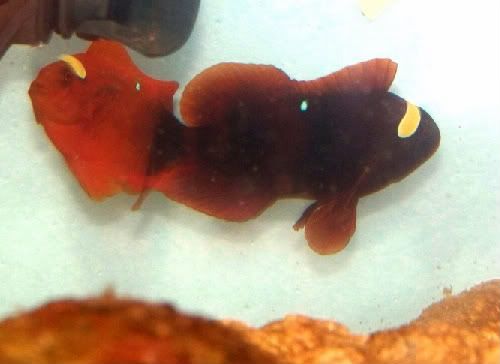
-
8 hours?
ok that's pretty quick. i did not know that. thanks.
i'm guessing it spreads faster in a heavily stocked tank?
Yap! that is one scary parasite
-
I'm going to agree with LemonLemon that its likely "water quality issues" ie. an ammonia spike.
While Brooklynella is more commonly associated with Clownfish it can and does affect other
marine fish. This protozoa multiplies rapidly and have been know to kill with within 8 hours.
Google The Brooklynella Parasite presented by Charles & Linda Raabe.
-
Is it a hybrid with other clownfish or a unique feature that are found in some specific region like the PNG Lightning Maroon Clownfish?
Cheers
Its not a hybrid all its features are that of a Maroon Clown such as the unique features of the Lightning Maroon. No Clownfish
found in the Yellow Stripe Maroon's home range has blue features. Chrysopterus is found only in Fiji, Tonga and The Solomon
Islands. That said the blue stripes of Chrysopterus is derived from reflective properties rather than "true blue color features".
Bicinctus may also have blue stripes, however the are found in the middle east.
This fish's features are likely unique. This is probably the only Maroon Clown currently in captivity to have a blue spot.
-
Is there a blue dot on the other side too?
The blue dot is just on the pictured side....
-
Premnas Biaculeatus
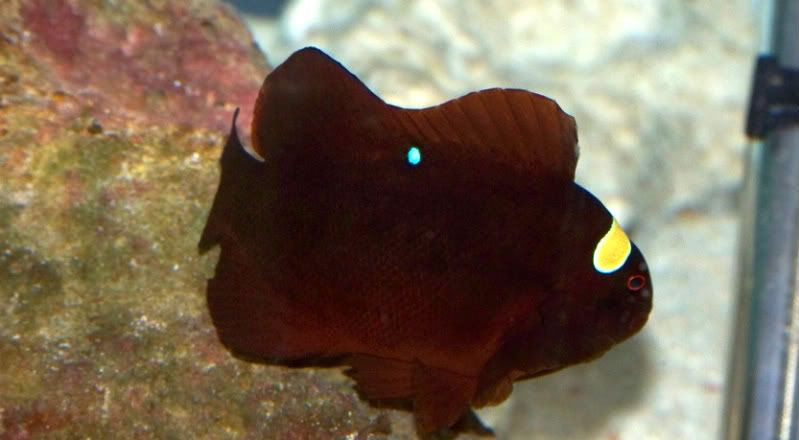
Blue Spotted Yellow Stripe Naked Maroon Clown ( Premnas Biaculeatus)
Extremely Rare this Naked Stripe Maroon is of the yellow stripe variety, Naked Stripe Maroons are more commonly of the white stripe variety.
To add to this already rare find is a blue spot/dot centered half way at the base of the dorsal fin. Just thought I'd share.
-
Yup this is what I fear also, so I seeing if anyone done that before.
All the 3 pair been with me close to a years, clarkii and saddleback around 3inch and perc around 2 inch. Actually they do chase each other once in a while but not a big issue.
Does each pair have a favorite spot or do they jostle for territorial rights
-
Hi guy,
I have a aglae blenny fish that is moving like a tank and knock down a lot of my frag. I tried to catch or trap it but it dun fall for it. Thinking of removing all the rock and coral in my tank, catch the fish then put back all the rock. I have mostly zoa and SPS, will the SPS be affected by this move? Anyone done that before?

I tend to agree with dieran_green, glue 'em. Any time you do any major aqua scaping such as you have suggested, you run the risk of upsetting and stressing the inhabitants.
Try a better brand and or stronger glue

I'm curious to know how you managed 3 pairs of Clownfish in the same tank without incident.
i) may I ask; how old and how big they are, clarkii,perc and saddleback.
ii) is each pair hosted by a nem.
-
Hi guy,
I have a aglae blenny fish that is moving like a tank and knock down a lot of my frag. I tried to catch or trap it but it dun fall for it. Thinking of removing all the rock and coral in my tank, catch the fish then put back all the rock. I have mostly zoa and SPS, will the SPS be affected by this move? Anyone done that before?

I tend to agree with dieran_green, glue 'em. Any time you do any major aqua scaping such as you have suggested, you run the risk of upsetting and stressing the inhabitants.
-
Nice! Thanks for sharing the info on the ID.
Are Omanensis collection allowed?
Cheers
JC
Unfortunately collection is still disallowed......
-
-
Interesting. If not for the lyretail they do really look a lot like dark variants of A. bicinctus from the Red Sea or even chocolate variant of A. akindynos from Australia.

Fuel, you're spot on. One could easily misidentify A.Akindynos(barrier reef anemonefish) for A.Omanensis and to a lesser extent the brown variation of A.Bicinctus.(found mostly around the Eliat coast of Israel). Except that the Oman Clownfish is endemic to the 1242 mile(2002KM) coastal shallows of Oman.
1st pic A.Akindynos........Middle pic A.Bicinctus.....3rd pic A.Omanensis

Using the three pics above as a reference guide here are the differences to note.
a) A. Bicinctus in the pic above is a brown variation generally found around the Eliat coast of Israel. It is also this variation that is commonly used in
CB. The 1st band of Bicinctus is generally thicker than that of Omanensis or Akindynos and generally not constricted or separated at the top. Its middle
band while generally narrow is still considerable thick than either Omanensis or Akindynos. Its caudal fin is generally yellowish and never white.
 Here are the differences between A.Akindynos and A.Omanensis. The pelvic and lower back fins of Omanensis is black while that of Akindynos is generally
Here are the differences between A.Akindynos and A.Omanensis. The pelvic and lower back fins of Omanensis is black while that of Akindynos is generally yellowish to yellowish brown. Their middle bands are narrow however that of Omanensis is much narrower with a scale count not exceeding 4 scales. Its
caudal fin is also strongly forked or as "Fuel" puts it Lyretail.
I hope this makes it a little easier to sort out the differences between these three Clownfish species.
-
OMG, Love the oman clownfish... So nice..
glad you like them..........
-
very nice.
oman clowns are indeed special and rare!
thanks for sharing the pics.
It was a pleasure sharing

-
Here are pics of a pair of A.Omanensis in their natural habitat and also pic of other residents
of the Omani Reef System. "Fuel" and Clownfish lovers in Singapore hope you like the pics.
A.Omanensis pair.
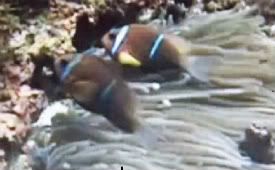
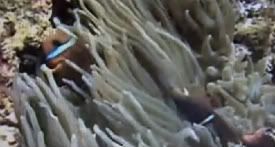
below photos of other Omani reef residents
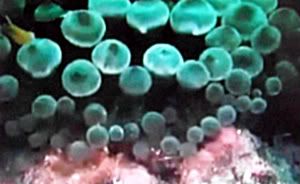
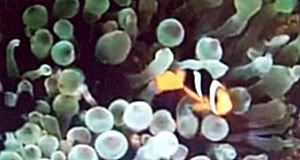
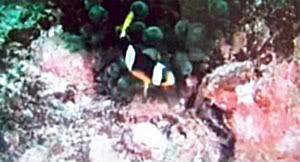
notice the mouth of the BTA top right corner
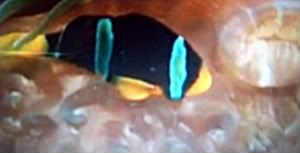
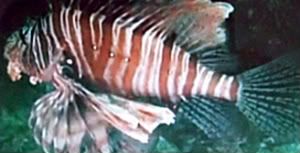
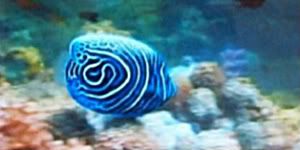
A happy camper in Oman

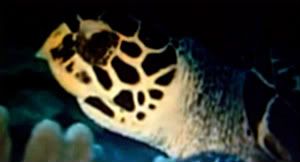
-
Got 1 species right.

Lemon, order Amphiprion barberi from Fiji!
should any of your questions including the other members be left unanswered it was not intentional. I'm still finding my way around your forum

-
Hi Zuma, I have them in a partitioned tank all by themselves. It might be the tank size as all I can give them now is a 15 gallon partition. But I'll just continue pumping them with food and hopefully get some eggs soon.
You're so lucky that you are able to collect your own clowns. I believe with you doing it personally, the clowns will be in much better shape upon reaching your tanks. The capture and holding facilities of some transhippers are just so laden with parasites, possible water quality issues which can affect the survivability of the fish considerably during and after shipping.
15gals is ok all my clownfish are keep as pairs or singles in 10&15gal tanks but each individual filter for each tank is meant for a 70gal tank.
Clownfish will not spawn if the feel unsafe. Is your partition such that other fish in the same tank is bothering them.
I agree with you on the capture,holding and transhipping. We are not certain if the use of toxic chemicals is still common during the capture process.
The already stressed fish is then further expose to parasites etc.
-
If u can get oman and fuscocaudatus i dont see any difficulty in you getting barberi.
its not too difficult... I just like collecting them myself.
-
Very true for perculas and ocellaris and other tropical clowns. I would'nt want to mess with temperatures too much as the chrysos are doing fine at the current temperature. As they are wild caught I would preferably stick to the temperatures found in the natural habitat and just wait for them to become "ripe". Photoperiod I might shorten by 2 hours and see how it goes. Hopefully they can breed without an anemone.

clownfish in captivity do not need an anemone to thrive or spawn.... chrysos come from water temperatures of 26-29C is your chryso pair in your main tank?
shorten your photo period gradually over a 3 week period it helps you fish to adjust without shocking them
-
I'm curious, what are the two other clownfishes u dont have now apart from fuscocaudatus?
Chagosensis and berberi
-
I'm curious, what are the two other clownfishes u dont have now apart from fuscocaudatus?
Chagosensis and berberi
-
I keep them 25.8-27 degrees celcius. I believe the cool water did help with these fish. Photoperiod is 14L:10D. I feed them pellets, blended seafood, frozen polychaete worms, gutloaded live adult brine shrimp. They are just not breeding. I'm not using an anemone for them though, I don't think it's compulsory? They have lots of small anemones to sleep in though (aiptasia).

in order for clownfish to breed ie. not take years
a) your water tempt should be between 82 n 84F I believe that would be 28-29C
 photo period 12 n 12 tropical hours are roughly 12 n 12
photo period 12 n 12 tropical hours are roughly 12 n 12c) feed them no less than 5 times daily, but keep an eye on water quality.
d) water quality ammonia=0 nitrite=0 nitrate below 5ppm
-
Yes will love to get to know you more. I have 2 adult pairs of Chrysogasters that are doing anything but breeding.
 I need to breed the rarer clowns. Breeding black ocellaris & perculas are getting awfully boring.
I need to breed the rarer clowns. Breeding black ocellaris & perculas are getting awfully boring.I'll be more than happy to give you advice on breeding etc.



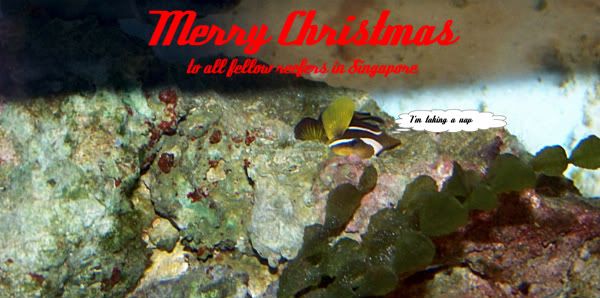
Wyoming White (WW)
in General Reefkeeping_
Posted
Several year ago, when Ibluewater started doing business with C-Quest, I had the distinct pleasure of getting to know its founder, the late Bill Addison. A significant amount of Joy Wilkerson's research and work on her Clownfish book was derived from information received through Bill's generosity in giving her full access to his breeding facility.
Bill and I had many conversations about the Wyoming White (WW) and how difficult it was to successfully breed them in any numbers. His experience was that every clutch of eggs produced less than 5% Wyoming Whites.
With some Clownfish, such as Latezonatus, over production made a once rare Clownfish more common.
Due to the difficulty and random results of spawning designer Clownfish like the WW, these will likely remain rare in the foreseeable future.
My friends at iBluewater were fortunate to have acquired several WWs from C-Quest just before they shut down operations in Puerto Rico. In hindsight, I believe iBluewater would have acquired any remaining WWs available to them.
Since C-Quest closed operations, I try to note practically every person or hatchery that had one or more pairs of WW. Rumors would occasionally surface that yet another attempt was made to spawn WWs. None seem to succeed.
Bob at iBluewater mentioned Sea and Reef Aquaculture and the excellent work they do. With their success spawning other species of Clownfish, he was very confident that they would be first to spawn the WW again. They are.
Congratulations Soren and team! Sea & Reef has successfully spawned the Wyoming White.